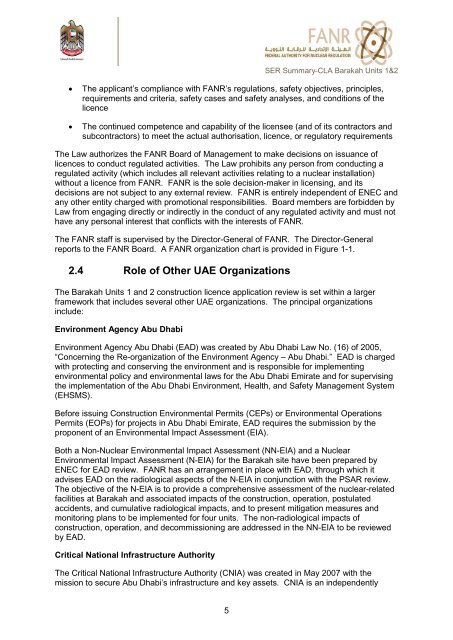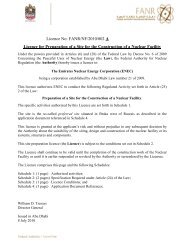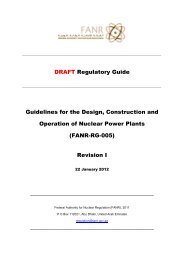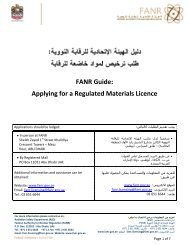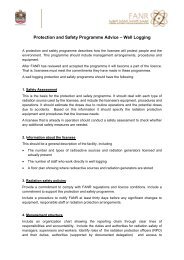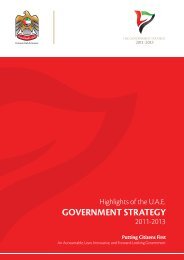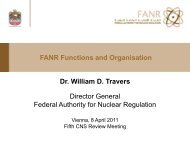Safety Evaluation Report of Barakah Units 1 and
Safety Evaluation Report of Barakah Units 1 and
Safety Evaluation Report of Barakah Units 1 and
Create successful ePaper yourself
Turn your PDF publications into a flip-book with our unique Google optimized e-Paper software.
5<br />
SER Summary-CLA <strong>Barakah</strong> <strong>Units</strong> 1&2<br />
• The applicant’s compliance with FANR’s regulations, safety objectives, principles,<br />
requirements <strong>and</strong> criteria, safety cases <strong>and</strong> safety analyses, <strong>and</strong> conditions <strong>of</strong> the<br />
licence<br />
• The continued competence <strong>and</strong> capability <strong>of</strong> the licensee (<strong>and</strong> <strong>of</strong> its contractors <strong>and</strong><br />
subcontractors) to meet the actual authorisation, licence, or regulatory requirements<br />
The Law authorizes the FANR Board <strong>of</strong> Management to make decisions on issuance <strong>of</strong><br />
licences to conduct regulated activities. The Law prohibits any person from conducting a<br />
regulated activity (which includes all relevant activities relating to a nuclear installation)<br />
without a licence from FANR. FANR is the sole decision-maker in licensing, <strong>and</strong> its<br />
decisions are not subject to any external review. FANR is entirely independent <strong>of</strong> ENEC <strong>and</strong><br />
any other entity charged with promotional responsibilities. Board members are forbidden by<br />
Law from engaging directly or indirectly in the conduct <strong>of</strong> any regulated activity <strong>and</strong> must not<br />
have any personal interest that conflicts with the interests <strong>of</strong> FANR.<br />
The FANR staff is supervised by the Director-General <strong>of</strong> FANR. The Director-General<br />
reports to the FANR Board. A FANR organization chart is provided in Figure 1-1.<br />
2.4 Role <strong>of</strong> Other UAE Organizations<br />
The <strong>Barakah</strong> <strong>Units</strong> 1 <strong>and</strong> 2 construction licence application review is set within a larger<br />
framework that includes several other UAE organizations. The principal organizations<br />
include:<br />
Environment Agency Abu Dhabi<br />
Environment Agency Abu Dhabi (EAD) was created by Abu Dhabi Law No. (16) <strong>of</strong> 2005,<br />
“Concerning the Re-organization <strong>of</strong> the Environment Agency – Abu Dhabi.” EAD is charged<br />
with protecting <strong>and</strong> conserving the environment <strong>and</strong> is responsible for implementing<br />
environmental policy <strong>and</strong> environmental laws for the Abu Dhabi Emirate <strong>and</strong> for supervising<br />
the implementation <strong>of</strong> the Abu Dhabi Environment, Health, <strong>and</strong> <strong>Safety</strong> Management System<br />
(EHSMS).<br />
Before issuing Construction Environmental Permits (CEPs) or Environmental Operations<br />
Permits (EOPs) for projects in Abu Dhabi Emirate, EAD requires the submission by the<br />
proponent <strong>of</strong> an Environmental Impact Assessment (EIA).<br />
Both a Non-Nuclear Environmental Impact Assessment (NN-EIA) <strong>and</strong> a Nuclear<br />
Environmental Impact Assessment (N-EIA) for the <strong>Barakah</strong> site have been prepared by<br />
ENEC for EAD review. FANR has an arrangement in place with EAD, through which it<br />
advises EAD on the radiological aspects <strong>of</strong> the N-EIA in conjunction with the PSAR review.<br />
The objective <strong>of</strong> the N-EIA is to provide a comprehensive assessment <strong>of</strong> the nuclear-related<br />
facilities at <strong>Barakah</strong> <strong>and</strong> associated impacts <strong>of</strong> the construction, operation, postulated<br />
accidents, <strong>and</strong> cumulative radiological impacts, <strong>and</strong> to present mitigation measures <strong>and</strong><br />
monitoring plans to be implemented for four units. The non-radiological impacts <strong>of</strong><br />
construction, operation, <strong>and</strong> decommissioning are addressed in the NN-EIA to be reviewed<br />
by EAD.<br />
Critical National Infrastructure Authority<br />
The Critical National Infrastructure Authority (CNIA) was created in May 2007 with the<br />
mission to secure Abu Dhabi’s infrastructure <strong>and</strong> key assets. CNIA is an independently


